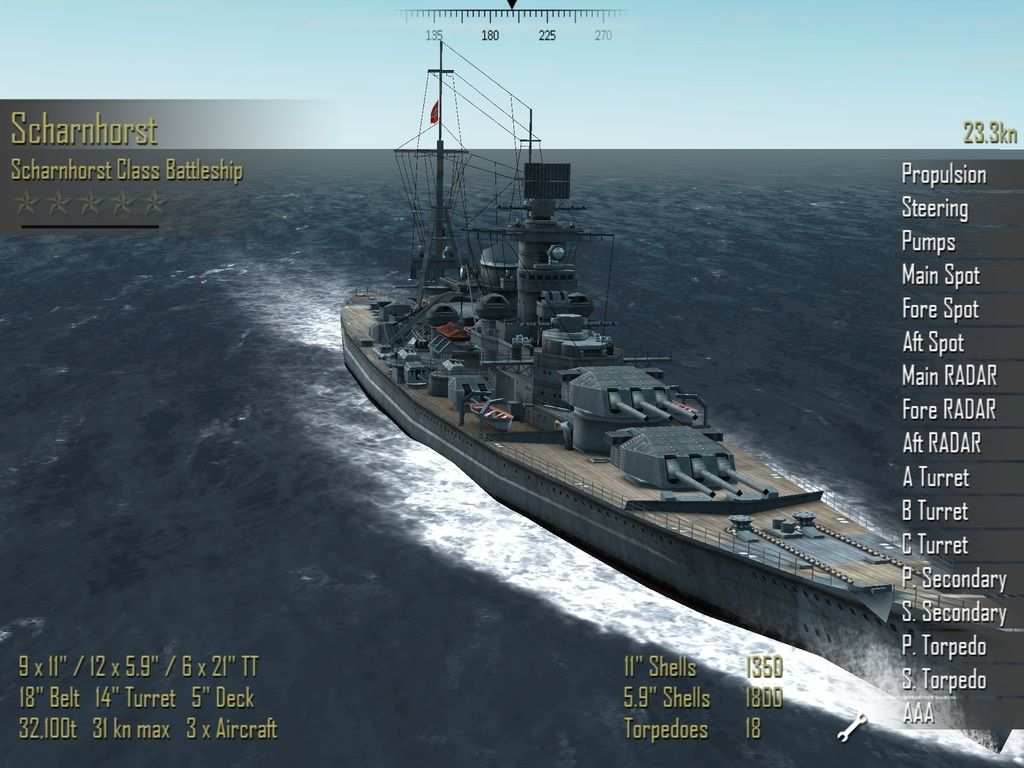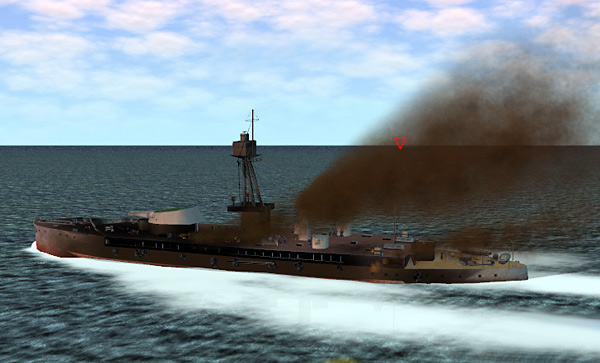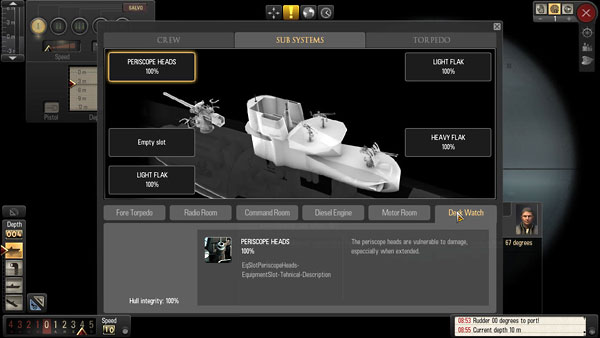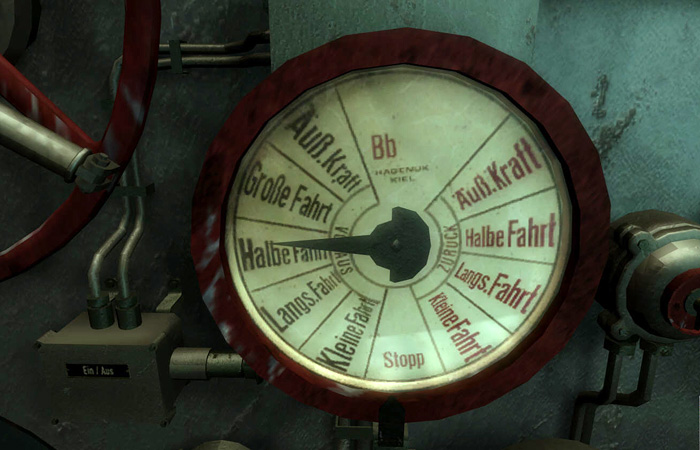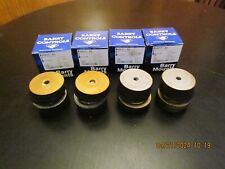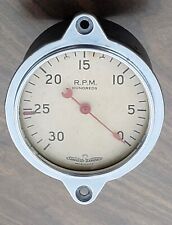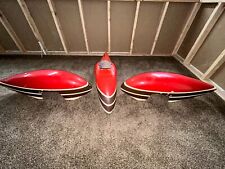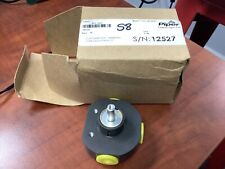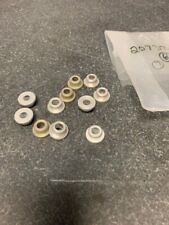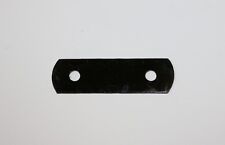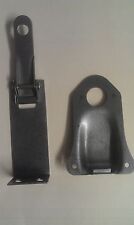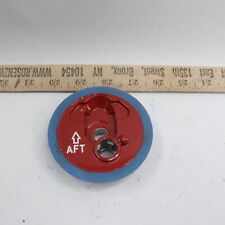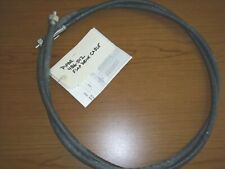Remember those dark days when German wolf-packs nearly brought Britain to starvation, and incredibly brave merchant sailors crossed the Atlantic under the guns of mighty battleships like the Scharnhorst, Bismarck and Tirpitz, who were in turn hunted by British battlecruisers such as Hood, Renown and Repulse?
And remember the good old days when a sim or strategy game came with a deeply researched dynamic single player campaign, challenging and intuitive AI, and a nice thick manual explaining all the detail about the conflict, and the game, for you to page through on your daily commute? Remember when the price for all of this seemed to match the value?
Well, those days are back thanks to the new title ‘Atlantic Fleet’ by Killerfish Games. a follow up to their earlier title, ‘ ‘Pacific Fleet’.
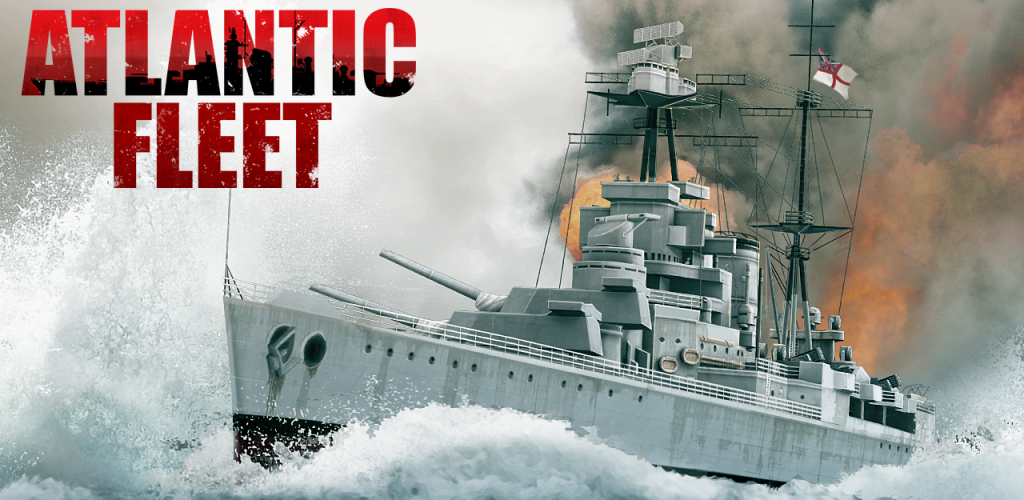
And here is the part that might shock you (until you see the credentials of the team behind it) – this is a 10USD iOS/Android game. Here we review their game, and speak to the developers.
Game essentials and price
Atlantic Fleet is a turn-based strategy game for iOS and Android, based on the successful formula Killerfish used in their previous title ‘Pacific Fleet’. In the past, iOS strategy games would fall into the ‘strategy lite’ category, but lately the mobile gaming genre is seeing more and more traditional turn based wargames and simulations being launched and Atlantic Fleet is no Angry Birds. This game has depth and immersion that a lot of PC sim and strategy titles could learn from.
Oh, really? Yes, really. To give you a taste, here is the German Battleship Scharnhorst in game (from an info screen showing status of all the ships modelled sub-systems).
And here she was in real life.
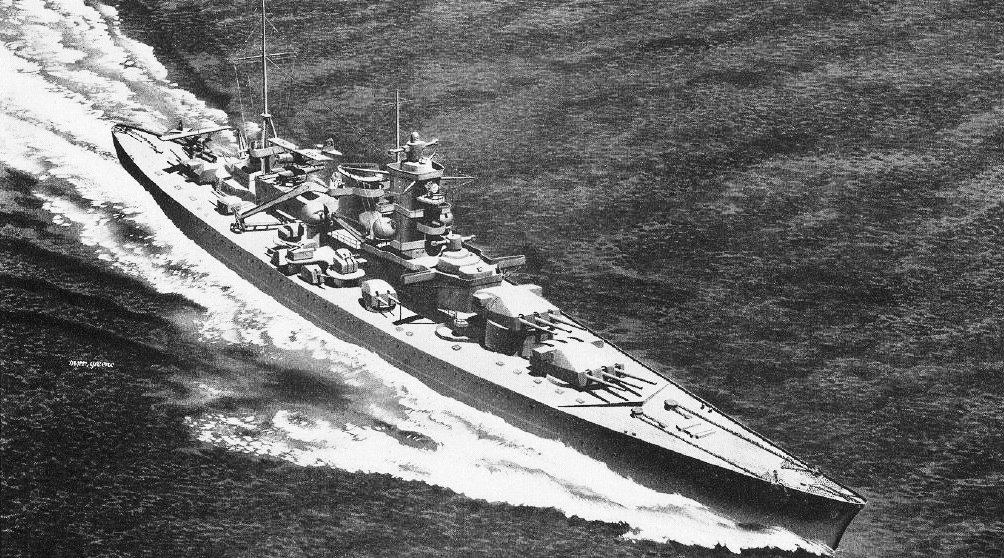
Source: Wikipedia
The Atlantic Fleet devs boast that it features 60 highly detailed historic ship models representing over 630 individual ships and 350 submarines. Oh, really? Well it so happens my grandfather Petty Officer Jack Lundie served in the Battle of the Atlantic, on HMAS Nizam. No way would his destroyer be in the game, right? Wrong.
OK, so it has a lot of pretty models, but it’s an iOS ‘strategy’ game, not a real sim right? Deep as a teaspoon…
“The ships are all made up of individual compartments with subsystems assigned to them which take damage depending on where a shell hits. Waterline or plunging fire will generally damage compartments causing flooding, and hits along the superstructure will tend to damage ‘soft’ equipment. Compartments that catch on fire may suffer secondary explosions that damage adjacent compartments or even cook off magazines. The hit decals are placed where the hits actually occur,” according to Killerfish co-founder Nils Ducker.
“The ships all sink dynamically because the compartments will always flood differently depending on where you hit them. So there are no hitpoints or canned animations here. Since we already had this basic system since Pacific Fleet and we wanted to add better submarine combat an underwater camera was must-have since pretty much day one. The underwater effects themselves went through several iterations before ending up what you see in the game,” he said.
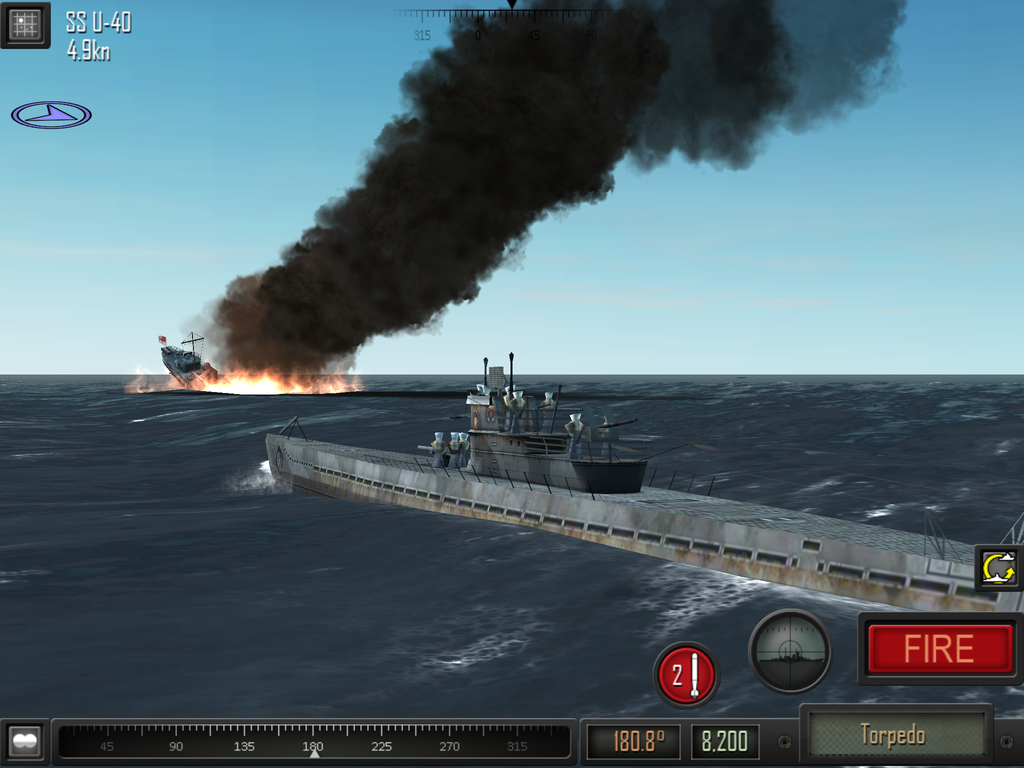
You will find yourself watching your victims sink, with morbid fascination.
If you’ve been holding off iOS games because you think they are too lightweight, this game might change your mind. Especially when you see how much game you get for your money.
I reviewed the latest version avail at the time, v1.08, on an iPad Air 2nd gen, and on an iPhone 6. Full price is 10 USD, with all features and game modes included (no annoying in-app purchases!). Download size is about 100MB. And there is a 65 page colour PDF manual available to walk you through the setting and the game.
Gameplay
There are three game modes – Single, Campaign, and Battle of the Atlantic mode. There is no online player vs player option but the devs say they might consider it for a future title.
Single mode can either be played as a custom battle where the player sets up the scenario, or as a series of about 20 set piece battles based on historical events. Here is one example of a Single Battle scenario:
Battle of the River Plate
13 December 1939
Raiding the South Atlantic since the start of hostilities, the Graf Spee has finally been cornered by three cruisers.
Historical Outcome:
Graf Spee – Scuttled
Exeter – Heavy damage
Ajax – Medium damage
Achilles – Light damage
Single battles are a good introduction to the mechanics of gameplay in Atlantic Fleet, and the historical missions give a nice guided tour through the ebb and flow of the battle and introduce the main combatants. Custom missions enable you to set up interesting scenarios. I tried for example to see if Grandpa Jack’s little destroyer the Nizam could get close enough to the German battleship Scharnhorst in a 1-1 battle, to sink it with torpedoes. (Answer: despite getting close, Grandpa Jack wouldn’t have made it home.)
Campaign mode is a series of missions of increasing difficulty in which the player fights to win, and earn ‘renown’ points which can be used to upgrade his fleet. You start with a lonely sub or destroyer, and can work your way up to Battleships and Carriers in a combined task force, with opponents getting tougher as you progress.
‘Battle of the Atlantic’ mode is the game’s full strategy mode, covering the years 1939 to 1943, and as this is where the game really shines, it is worth spending a bit more time explaining.
You start by choosing sides. As the British, your job is to get the convoys through and stop Germany from raiding your convoys. As the Germans, it is all about tonnage sunk. Germany can win the battle if it is able to consistently sink 300,000 tonnes of shipping a month before America enters the war in 1941, or 700,000 tonnes a month after that.

The campaign starts, and the British fleet is spread thin, from the Med to the US coastline.
Next is fleet selection. As with any turn based strategy game involving resource management, you have some points to spend on your starting fleet, and choices to make about how to spend them. Historically, the Germans relied in the early battle on their submarines, and on powerful surface raiders like the Graf Spee and Bismarck, often operating alone or with a small escort. They got some early victories, but soon the entire British Home Fleet was out looking for them, and one by one they were either sent to the bottom or sent scurrying back to port. You have full freedom over your own disposition of forces as both British and German commander, which lends itself to a lot of ‘what if’ gameplay. What if Germany had kept its fleet together and sent its combined fleet up against the British fleet in 1941 instead of spreading itself thin. What if Germany had put all its focus on submarines, rather than wasting so much effort on a few huge battleships. What if the British had been able to provide more and better escorts to their hapless convoys? You can put these questions to the test as you set up your fleet.
Fleet selection has a big effect on your gameplay: spending all your resources on big battleships instead of cheaper, nimble destroyers will help you against other Battleships, but leave you vulnerable to subs. A wolfpack is great for sinking a few freighters, escorts, even battleships but can be quickly out of position and range against a zig zagging convoy, and useless if the escort includes anti submarine destroyers. British Carriers? Don’t even bother (see below).

Oh, my grandfather also served on a ‘Q Class’ destroyer, the HMAS Quickmatch. I wonder if…yep, sure enough.
Strategic gameplay
Once that is done you move the map screen, showing the Atlantic area of operations. This is where your battle is really won or lost, so pay attention! The strategic map screen holds a wealth of information.
“We found out early on that our knowledge on the Battle of the Atlantic was pretty lacking, to say the least. So we started researching the topic more in earnest and found there were quite a lot of surface battles in the theatre. Because we wanted to make a more sim-like game, we researched firecontrol systems, gunnery tactics, technical references and narratives of the various battles so that we could build systems that worked reasonably life-like. We used ‘The German Fleet At War: 1939-45’ as a primary reference for the historical battles. And because we wanted the dynamic campaign mode to generate realistic battles we researched everything from convoy routes to weather patterns,” said Nils.
You can see this research reflected in the strategic map interface, key below:

(1) War Summary Bar
Indicates the balance of the tonnage war. When it goes completely red, Germany wins.
(2) War Summary
Shows how your battle is progressing, and enables you to review your fleet (including supply status, ammunition, damage, skill and experience levels).
(3) Display all zone names and location of ports/supply vessels.
Zones with a red tanker symbol contain supply vessels. Ending the turn in this zone will automatically rearm ship (Axis only).
(4) Show allied convoy routes.
Convoy routes and frequency change and are historically based.
(5) Zone Weather
Several types ranging from clear to snow storms. The electrical storms are quite visually spectacular! Follows meteorological patterns of the Atlantic with Westerlies, Trade Winds and seasonal changes. Poor weather decreases detection of enemy ships in the same zone. Impacts maximum visibility for combat in that zone. Use bad weather as cover to move about the map with less chance of detection.
(6) Show number of player warships and submarines in zone.
Shows the number of player warships and submarines in each zone. Warships and submarines act independently in combat. If an encounter occurs in a zone containing both warships and submarines, either all the warships or all the submarines will engage the enemy. Enemy warships or submarines encountered in a battle or from an event during the last turn are shown in red (Axis) or blue (Allies) to indicate their activity in that zone.
(7) Next Turn
Each campaign turn = ~3.5 days (8 turns per month).
After each player turn the following happens:
– Enemy ships move.
– Combat may occur in zones containing warships/submarines of both factions.
– Non player controlled ‘Events’ may occur (non-merchants may be damaged, but not sunk by events).
Events include: attacks on unescorted merchants, submarine attacks on unescorted warships, air attacks against shipping and naval bases.
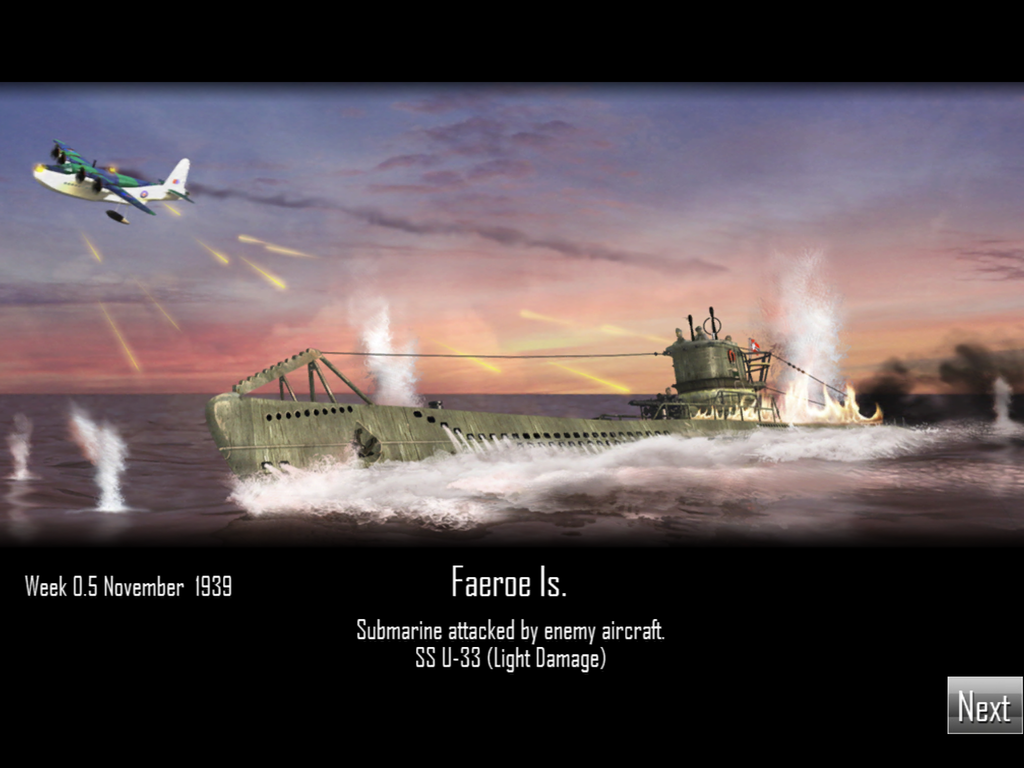
Not every contact results in a 3D player fought battle, only the more interesting ones, but these events are reported in splash screens. Merchant tonnage sunk during ‘events’ count towards the tonnage tally of the war. Warships and submarines cannot be sunk by events, but they can be damaged, sometimes heavily. This damage is permanent until repaired in a port.
As you can see, there is a lot of information, a lot of parameters impacting your game, and a lot of choices. Starting to sound like a serious sim after all?
As you move your fleet around the Atlantic, you need to consider the weather, time of year, and the convoy routes being used by your enemy. Repair and rearming needs to be managed too, as your fleet takes punishment and uses up ammunition, and sustains damage or losses which can only be repaired in friendly ports. As your ships gain combat experience their crews get better at repairing damage, and hitting their targets, so you also need to think about your fleet mix to be sure you don’t pair inexperienced ships with others just as green.
Tactical gameplay
Once you have moved your fleet on the map, battles are resolved where the two fleets have come into contact. Now you move into a beautifully represented 3D view of the battlefield, with your fleet and the enemy fleet shown. What happens next is down to your skill at maneuvering and firing!

(1) Action Button / Gun Settings
(1a) Red number shows current gun bearing (attack angle).
(1b) Green number shows current gun elevation (distance).
You can have any of the following attack options, depending on your ship type:
-AP Shells (primary guns)
-HE Shells (primary guns)
-AP Shells (secondary guns if applicable)
-HE Shells (secondary guns if applicable)
-Star Shell (illumination round)
-Depth charge (or ‘Hedgehog’)
-Torpedo
-Air attack (carriers and battleships with aircraft can launch them, or destroyers and subs can call in land based aircraft such as Stuka, Ju88, Condor, or Sunderland.)
(2) Bearing Line (Attack Direction)
Line extending from ship shows direction weapons aimed. Guns can only fire if they have line of sight, and damage to a gun may make it unable to fire.
(3) Adjust Bearing (Attack Angle)
Adjusts guns bearing (attack angle) until bearing line points at an enemy ship.
(4) Set Target
(5) Target Solution
The target solution shows information about the current target. Note that damage to directors (Spot) and RADAR decreases the accuracy of the target solution.
(6) Adjust Elevation (firing distance)
Gun elevation limits vary by gun and are historically based.
(7) Wind Meter
Deeper blue = stronger wind. Wind may effect flight of shells and should be compensated for if this option is enabled. Wind also determines the direction of smoke screens.
(8) Fire
Fires selected guns using set bearing (attack direction) and elevation.
(9) Splash History
Indicates whether last salvo fired at target was long, short or straddled / hit. Automatically adjusts for movement of ships between turns.

You also have access to a ‘gun plot’ screen which you can also use to judge the fall of your shot, track the movement of your targets and plan your tactics – absolutely critical if your target is damaged and retiring under smoke, so that all you have to guide your gunnery is dead reckoning.
Engagements can occur on the surface with guns, below it with submarines and torpedoes, or from the air, as you send in torpedo planes or land based bombers. Sub warfare is especially challenging and the ability to see the action under the water, as torpedoes are fired and depth charges explode, is very atmospheric.
Submarine combat is an art that takes skill to perfect in Atlantic Fleet. Says Nils Drucker, “The subs are very useful against surface ships if they are in a good position. One torpedo is often enough to sink a merchant if you hit them in the centre. With the subs it is important to resist the temptation to quickly open fire and stalk the convoy over several turns to see if, when, and how they zig-zag. There is a ‘sweet spot’ between the 1000yd minimum range and the distance the torpedo will travel in the initial turn (2000yds for Germans and about 3000yds for the British) where if you can close to within this range you are guaranteed a hit.
“Also, the merchants tend to flee in the opposite direction to your attack, so if you have multiple subs they may prove useful even if they start off in what seems like a poor position. It is possible to ‘herd’ the convoy into multiple attacks. The subs are also much harder to see when running on the surface than surface ships so you can run fast on the surface to relocate. If the convoy has only a single escort, multiple subs can easily overwhelm it. If the merchants are running away, pelt them with HE gunfire to slow them down.”

Too close for comfort. A destroyer makes a depth charge run over a u-boat in ‘Atlantic Fleet’.
Another well implemented feature is that you and the AI can use smoke to obscure yourself or your fleet. Use it well (remember the wind indicator) and you can screen an entire convoy while it runs away from German raiders, or cover your wounded battleship as it retires. The AI also uses it well, and seems to know when to stay and fight, and when to quit and run – with a preference for staying and fighting which is good from a gameplay perspective. The AI is very good at playing to its strengths – Battleships will try to stay at optimal range to engage, rather than charging in to attack you, while destroyers will dodge and weave and try to get in close. I have to say, and this is a huge complement, I have not seen the game AI do anything stupid in my testing: eg breaking off from a submarine engagement and sailing away like a sitting duck, engaging Battleships with destroyers, leaving Carriers unprotected; none of these or similar things that bad AI will typically do. Full credit to the coders here.
As you will see, getting shells on target is no simple matter in this game and that makes every tactical encounter nervewracking. After several hours of practice, I can land shells on my target about 50% of the time. So even though you go into battle with a pocket battleship and a couple of cruisers against a cruiser and a couple of destroyers, unless you manage to get your first salvoes on target, you can take a lot of damage and end up running away with your tail between your legs!
Weather, position, speed, smoke and maneouvering all impact the chances of you and the AI hitting your target. “In fact every ship has a simulated fire control crew that continously calculates a solution based on range estimates and hits. You will find that once you start scoring hits, the elevation estimate will usually become pretty accurate. You cannot just ‘follow the counter’ though, you really need to overshoot/undershoot to quickly nail the range. If you maneuver, this will affect the enemy’s solution negatively and vice versa. Subs are harder to detect as a whole, and this detection range is further limited at night or in bad weather.”
On the iPhone 6: while it can be played on iPhone, this is a game for tablets or phablets. Text and context menus don’t resize for the phone, so even hitting the correct menu choice can be hard for meaty fingers, let alone managing a firefight between a dozen ships in tactical mode. The game does not synch across devices, so you can’t start a campaign on tablet, and continue it on phone. iPhone 6/5/4 therefore not recommended.
Options
There are a wide range of customisable parameters, as shown in this image. Some options impact gameplay and difficulty, while there are also a couple of basic graphic options. On the iPad Air2 and iPhone 6 I found no problems running the game on ‘high’ settings.

Once you have mastered the basics, I strongly recommend increasing your engagement range to give yourself more room in which to plan your meeting engagement, and reducing ‘renown’ points by 50% to give yourself more of a challenge. I found in the Battle of the Atlantic campaign it was too easy to earn points and keep my fleet fully operational – less renown makes it hurt more every time one of your ships is hit or lost as the cost of repairs and replacements starts to get out of reach.
Graphics, sound and immersion
These are clear strengths of the title. Just because this is an iOS/Android title doesn’t mean sacrifices have been made on the damage model, or the visual effects, as the shots below show.

Weather, sea conditions and damage modelling are a visual feast. No two engagements will look the same.
Shell strikes show impact where they hit and even splash effects are spectacular and differ depending on the type and calibre of the shell. Different weapons are modelled with a nod to historical reality regarding range and accuracy, and even period. For example, the British Hedgehog and Squid antisubmarine mortars are modelled, and in the game are much more likely to kill a sub than the older depth charge weapons. In real life, these new mortars took the kill rate for British destroyers from 1.6% per attack, to nearly 20% and you can clearly see this in the game. British torpedoes have a shorter range than their German counterparts, and ‘duds’ are modelled too.
Damage is local and shown as it happens. Hits to superstructure won’t sink a ship, but hits to the waterline will. It pays to concentrate your fire on one side, as buoyancy effects are modelled so if you flood a ship on both sides with hits on each side, the flooding will balance the enemy ship and may prevent it sinking. Depending on where you hit your target, you can disable specific weapon systems, flood torpedo tubes, or flood different compartments. It is particularly satisfying when you are able to deliberately target the stern of an opponent to damage his steering, and then get behind him, knock out his rear turrets and then hammer him until he rolls over. This type of gameplay is only possible because of game is so precise about shell impact.
The visual effects when a ship sinks are particularly well done. Because the damage model is so specific, no two ships sink the same way. Some go up in a huge fireball as magazines or fuel explode, while others slide slowly under the waves, leaving only a patch of oil or flaming fuel behind them. Some will burn for a period, before exploding in spectacular fashion later in the engagement when the fire reaches a magazine.
The game even shows what is going on under the water.
You can see your sub scrape by underneath an enemy destroyer, and watch as it is depth charged. You can follow your torpedoes into the enemy hull and see the holes in the hull where they exploded. And if you manage to sink your enemy, you can watch them slide down to Davy Jones locker, shedding equipment, fuel, oil and air as they go. No matter how many enemy ships I’ve sunk, this is still a sad but compelling sight.
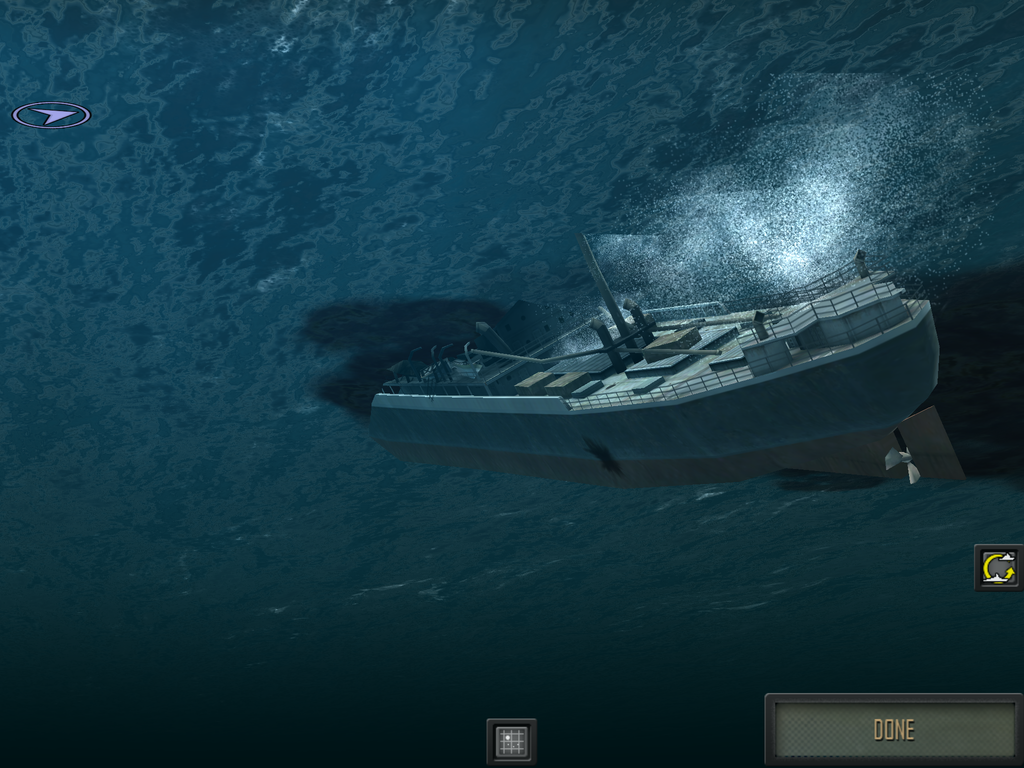
Oil pooling on the water, air bubbling up from its holds, the view of a merchant ship sinking as seen from below. Ships creak and groan, fire crackles and metal crunches as they sink.
Sound effects are well done, with a rousing musical score by Alexi Aubry-Carlson who is also the man behind the soundtrack for Xenonauts.
Different calibre weapons have their own bark or boom. The different classes of ship fire off their salvoes differently, and the ripple of the guns firing is clearly heard. Given the attention to detail in this title, I have no doubt that if the Flower Class guns in this game fire in a single salvo, while the main guns of the Bismarck fire in sequence fore to aft, this is how it was in real life. And honestly, I am simply gobsmacked that this level of detail is even included in a 10 USD iOS title.
Quibbles
Yes, I like the game. It has depth, detail, immersion and engaging gameplay. But it’s not all blue water sailing…
Aircraft carrier ops: Carriers are expensive and too easily killed. The devs admit this is not a high point of the game design, “Well, the carriers are pretty much a holdover from Pacific Fleet and we retained them mostly because the planes bring some variety to the combat. We also attempted to make the carriers more realistic but in hindsight this was perhaps not so good decision. While they are playable they remain a compromise between realism and fun. If you keep it out of enemy gun range the carrier can be useful. Planes used to be too easy to get shot down and we decreased the effectiveness of AAA in the last update,” says Nils Ducker.
Winning the Battle of the Atlantic mode as German: I have played one Brit and one German campaign all the way through to early 1942, and it is much easier to win as Britain, vs Germany. The victory conditions for Germany are that you must sink 300,000 tonnes a month pre December 1941, rising to a massive 700,000 after the US enters the war. As Britain you just have to prevent this. The problem for Germany is not whether you can sink the convoys in battle – in most engagements I manage to send the escort to the bottom and sink all the freighters with of course losses on my side, but manageable losses. The problem is finding the convoys in the first place as the serious convoy activity does not start until the middle of 1940. The first few months of the German campaign feel like ‘whackamole’ moving your fleet around the Atlantic and hoping to run into a convoy. I challenged Nils Ducker on this and he replied that, “Well the (combat) zones are pretty big so having only one or two ships in a zone means it is hard to find the proverbial needle in the haystack. The weather also impacts this: storms mean engagements are less likely which you can use to your advantage (as Germany) when breaking out into the Atlantic. The weather actually moves according to the real life patterns which again can be used to mask your units. You will notice that tonnage will increase over time as more and more convoys are shipped over. I myself did not attain the 300k/month until around spring 1941. So there is a short window of opportunity as the Germans to win before the US enters.”
Drawn out battles: Once you get better at gunnery, you might get lucky and dispatch a convoy escort quickly, leaving you to slaughter the convoy at your leisure with no risk of return fire. Although good gunnery practice, this can be very tedious if there are several freighters in the convoy, as you have to sink them all before the battle can be ended. There should be a ‘quit battle’ option which calculates the end result for you and lets you leave such battles earlier if there are no longer any enemy combatants left, just freighters.
Conclusion
This impressive game costs about the same as a fast food meal, but offers you a three course dinner you won’t tire of.
The good: incredibly detailed ships, damage models, and challenging gameplay modes, very competent AI, and a low flat price with no ‘in game purchases’.
The not so much: small quibbles, most of which could be easily fixed
Score: 9/10
If you like this, you should also try: Pacific Fleet, Battle Academy I & II, Panzer Corps.
You should also read this book: A Flock of Ships, by Brian Callison. Easily the best novel about the Atlantic convoys ever written.
Future projects?
Killerfish Games is an independent developer consisting of Paul Sincock and Nils Ducker. Paul has worked in the systems biology field and software development in Silicon Valley, while Nils has worked on Battlefield 3 (EA DICE), the Little Big Planet franchise and The Perils of Man. They outsource a lot of content like additional artwork, effects and the soundtrack. The artist Przemek who did most of the effects and the various event images has worked in the Strike Fighters mod community where he is well known for his terrain mods and cockpits.
As for future projects they are currently working on a new game. No public detail yet but it is a naval game and it will be realtime.
Read more: http://simhq.com/forum/ubbthreads.php/ubb/viewmessage/message/83835/gonew/1#UNREAD#ixzz3hnzdPNFX
Follow us: @SimHQ on Twitter | SimHQ on Facebook

